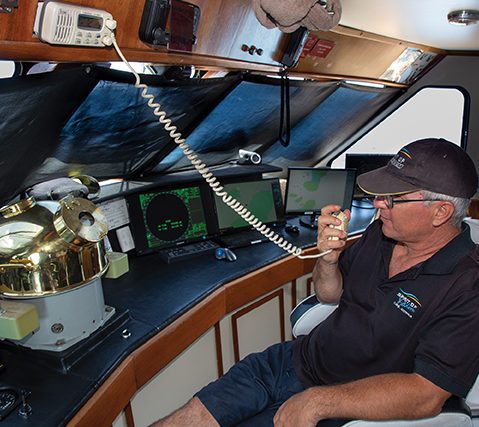BOAT SAFETY
EQUIPMENT

THE SAFETY EQUIPMENT NEEDED for boat diving can be divided into three categories: assisting or reaching equipment, signaling equipment, and first aid equipment. Local regulations may require you to have certain equipment; the recommendations in this article are intended to supplement any mandatory safety gear.
ASSISTING/
REACHING EQUIPMENT
A tagline should be deployed off the stern of the boat so divers can hold themselves in place while waiting to board the vessel or pull themselves to the boat in the case of a current. The length of the line will vary, but it should float on the surface, and a small buoy at the end of the line may be useful.
Another helpful item to have on hand is a throw bag, sometimes called a throw line. A throw bag is a bag that holds 75 to 100 feet (22 to 30 meters) of floating braided line. The responder grabs the tail end of the rope and throws the bag — ideally beyond (over the shoulder of) the person in need of assistance. These are very handy in assisting divers who may be tired or struggling against the current to get back to the boat.
A reaching pole or boat hook is another handy tool to have. It can be extended and used to assist a diver who is closer to the boat or even to snag a piece of gear or debris that should not be in the water.
Signaling Equipment
Every vessel should have more than one way of communicating in the event of an emergency.
Verbal communication can be achieved several ways. On dive boats it is usually via two-way radio. In the United States, the emergency channel is channel 16. If the vessel is in range of a cell signal, a cell phone can also be used. For boats that operate outside of cell range, a having a satellite phone may be advisable.
A flare gun can be used to signal other vessels to come render aid. Flares come in day, night and day/night options.
Many vessels also have an emergency position-indicating radio beacon or EPIRB. This device automatically activates and sends out a constant signal, which is used by search and rescue teams to locate the emergency and provide assistance. Some low-tech options for signaling devices are a signaling mirror and a loud whistle.
FIRST AID EQUIPMENT
Every vessel should have the equipment necessary to deal with minor to moderate injuries. At a minimum, a good first aid kit should contain personal protective equipment (PPE), items to stop bleeding (including a tourniquet), a few cravats, splinting material, bandages for minor cuts and scrapes, and some waterproof paper and a pencil to take notes.
Other recommended items include cold and heat packs and a DAN Neurological Assessment slate.
An oxygen unit is another essential piece of equipment for dive boats. The size of the unit and the delivery system(s) should be determined by your training and the distance to definitive medical care. To learn more, enroll in a DAN Oxygen First Aid for Scuba Diving Injuries course.
Another recommended piece of first aid equipment is an AED, or automatic external defibrillator. These require proper training, which is part of most CPR courses. With an AED, you are far more likely to successfully rescue a person experiencing a cardiac event than you are without one.

DAN Customer Service
Mon–Fri, 8:30 a.m. – 5 p.m. ET
+1 (919) 684-2948
+1 (800) 446-2671
Fax: +1 (919) 490-6630
Email: Member@DAN.org
24/7 Emergency Hotline
In event of a dive accident or injury, call local EMS first, then call DAN.
24/7 Emergency Hotline:
+1 (919) 684-9111
(Collect calls accepted)
DAN must arrange transportation for covered emergency medical evacuation fees to be paid.
Medical Information Line
Get answers to your nonemergency health and diving questions.
Mon–Fri, 8:30 a.m. – 5 p.m. ET
+1 (919) 684-2948, Option 4
Online: Ask A Medic
(Allow 24-48 hours for a response.)
